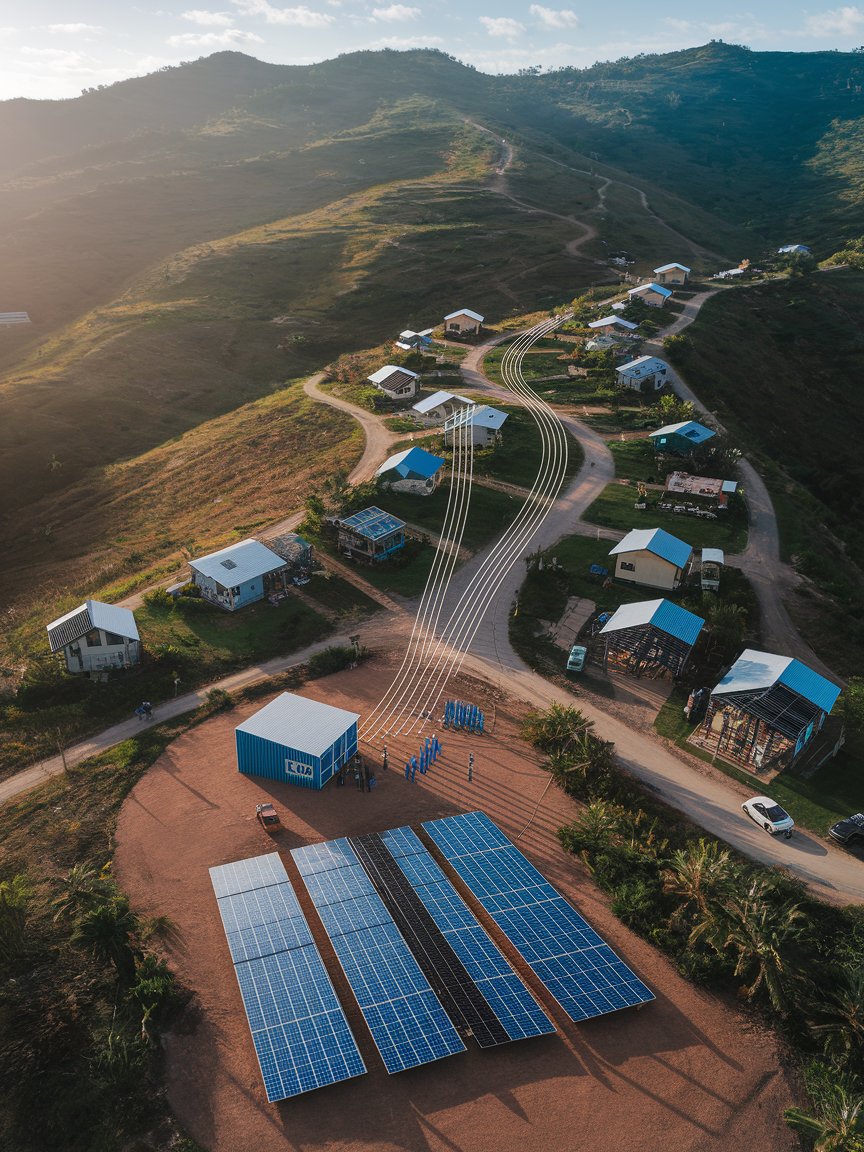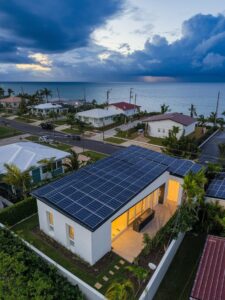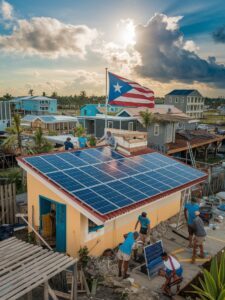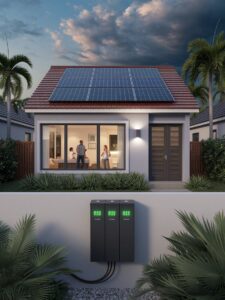
When Hurricane María devastated Puerto Rico in 2017, it exposed not just the vulnerability of the island’s centralized electrical grid but also profound inequities in disaster recovery. Remote rural communities, economically disadvantaged urban neighborhoods, and mountainous regions experienced the longest delays in power restoration—some waiting nearly a year for reconnection to the main grid. This disparity highlighted how traditional infrastructure often reinforces existing social vulnerabilities rather than alleviating them. In response, a promising model has emerged across Puerto Rico: community solar microgrids. These locally controlled energy systems combine solar generation, battery storage, and specialized control equipment to create islands of power that can operate independently from the main grid during outages. Green Power Solar Systems has been at the forefront of this movement, partnering with communities to design, finance, and implement microgrids tailored to local needs and resources. This blog explores how these solar-powered microgrids are transforming Puerto Rico’s approach to community resilience, particularly in historically vulnerable areas. Beyond merely providing emergency power, these systems are creating new models of energy democracy, economic development, and social cohesion that offer lessons for climate-vulnerable communities worldwide as they prepare for an increasingly uncertain future.
H2 Section 1: Understanding Microgrids: Technology and Topology (2 paragraphs, 155 words)
Understanding Microgrids: Technology and Topology
A microgrid represents more than just a collection of solar panels and batteries—it’s an integrated energy system capable of generating, distributing, and managing power at a community scale. The technical architecture typically includes distributed generation sources (primarily solar in Puerto Rico’s context), energy storage systems, sophisticated control electronics, and a physical distribution network. The defining characteristic of a true microgrid is its ability to “island” from the main electrical grid during disruptions, continuing to provide power to connected buildings through carefully managed energy flows. This capability requires specialized equipment including automatic transfer switches, protective relaying, and control systems that can balance supply and demand within the isolated network.
Green Power Solar Systems has implemented various microgrid topologies across Puerto Rico, each designed to address specific community needs and physical contexts. These range from simple shared systems connecting a handful of neighboring buildings to comprehensive neighborhood networks serving dozens of structures through underground distribution lines. Some operate as primarily backup systems, remaining dormant until grid failures occur, while others actively manage community energy flows continuously, optimizing for cost savings and solar utilization during normal operations while maintaining readiness for emergency conditions.
H2 Section 2: Identifying Vulnerable Communities (3 paragraphs, 220 words)
Identifying Vulnerable Communities
The concept of vulnerability in the energy context extends beyond mere exposure to hazards like hurricanes or earthquakes. True vulnerability emerges from the intersection of multiple factors: geographical isolation, socioeconomic challenges, critical service needs, and historical patterns of infrastructure investment. In Puerto Rico, the most energy-vulnerable communities typically exhibit several of these characteristics simultaneously. Mountain communities in the island’s central regions face physical isolation that complicates grid repairs after disasters. Economically disadvantaged urban areas often contend with aging electrical infrastructure that fails frequently even during normal conditions. Remote coastal communities can be cut off entirely when roads and bridges connecting them to population centers are damaged.
Beyond geography and economics, functional vulnerability must be considered when prioritizing microgrid development. Communities housing significant populations of elderly residents, individuals with disabilities, or those dependent on electrical medical equipment face heightened risks during outages. Similarly, neighborhoods with critical shared services—such as communal water pumps, health clinics, or emergency response facilities—experience cascading impacts when these services lose power. Green Power Solar Systems utilizes a comprehensive vulnerability assessment tool that integrates these various factors to identify communities where microgrid implementation can deliver the greatest resilience benefits.
This assessment approach has identified particularly high vulnerability in several regions: the central mountain municipalities including Utuado, Adjuntas, and Orocovis; coastal communities in Humacao, Yabucoa, and Loíza; and economically disadvantaged urban areas in San Juan, Ponce, and Mayagüez. In each of these regions, Green Power Solar Systems has partnered with local organizations to develop community microgrid projects tailored to specific vulnerability profiles and resilience objectives. These collaborations have yielded insights about the importance of addressing both technical and social dimensions of energy vulnerability through participatory planning processes that center community knowledge and priorities.
H2 Section 3: From Concept to Reality: Implementing Community Microgrids (2 paragraphs, 160 words)
From Concept to Reality: Implementing Community Microgrids
Successful community microgrid implementation follows a distinct development pathway that begins long before equipment installation. The process starts with community engagement—building relationships with local leaders, conducting educational workshops about energy systems, and facilitating collective decision-making about system priorities and governance. Green Power Solar Systems employs a team of community energy coordinators who spend months working with residents to develop shared understanding of options, constraints, and opportunities before any technical design begins. This participatory approach ensures systems reflect genuine community needs rather than externally imposed assumptions.
The technical implementation phase involves detailed energy audits of buildings to be connected, solar resource assessment, identification of suitable locations for equipment, and engineering design tailored to local conditions—particularly wind resistance requirements in hurricane-prone areas. For larger projects, our team often develops a phased implementation strategy that allows for initial critical infrastructure protection with subsequent expansion to additional community buildings. This approach delivers immediate resilience benefits while creating flexibility to incorporate emerging technologies and adapt to changing community needs over time. The installation process typically employs local workforce whenever possible, building community capacity to maintain and operate these systems independently.
H3 Subsection: Case Study – Toro Negro Community Microgrid (3 paragraphs, 200 words)
Case Study: Toro Negro Community Microgrid
The remote mountain community of Toro Negro in Ciales municipality epitomizes the challenges facing Puerto Rico’s most vulnerable regions. Situated in the island’s central mountain range and accessible only by a single winding road often blocked by landslides during heavy rains, this community of 27 families waited more than 11 months for grid power restoration after Hurricane María. During this extended outage, residents relied on a few shared portable generators, pooling limited resources to purchase fuel transported up the mountain by volunteers. The community, primarily dependent on agriculture and home-based enterprises, suffered severe economic impacts as crops spoiled and businesses ceased operations.
In 2019, Green Power Solar Systems partnered with the Toro Negro Community Association to develop a comprehensive microgrid solution funded through a combination of federal disaster recovery grants, foundation support, and community contributions. The implemented system includes a centralized solar array with 37 kilowatts of generation capacity mounted on an engineered ground structure designed to withstand 165 mph winds. Energy storage consists of a 104 kilowatt-hour battery bank housed in a reinforced concrete enclosure that doubles as a community charging center. Underground distribution lines connect critical community buildings including the health outpost, community center, water pumping station, and small business incubator space.
Since its activation in early 2020, the microgrid has maintained 100% uptime through multiple grid outages, including a three-week disruption following the January 2020 earthquake sequence. During these events, the community center powered by the microgrid has served as a regional hub providing charging services and refrigeration for neighboring communities. Beyond emergency operations, the system has reduced community energy costs by approximately 85%, with savings directed to a maintenance fund and educational scholarships for local youth. Most significantly, several families who had relocated after Hurricane María have returned to Toro Negro, citing the energy security provided by the microgrid as a key factor in their decision—demonstrating how energy resilience directly contributes to community preservation in vulnerable regions.
H2 Section 4: Financing Models for Community Energy Resilience (2 paragraphs, 145 words)
Financing Models for Community Energy Resilience
Financing represents one of the most significant barriers to microgrid implementation in vulnerable communities, which often have limited resources for capital investments despite facing the greatest need for resilient infrastructure. Green Power Solar Systems has pioneered several innovative financing approaches to address this challenge. The most successful model combines multiple funding streams: federal disaster recovery funds (particularly FEMA’s Building Resilient Infrastructure and Communities program and HUD’s Community Development Block Grants), foundation grants focused on climate resilience, municipal bond issuances, and community capital raised through cooperative structures.
Beyond initial capital formation, sustainable microgrids require financing models that support ongoing operations and maintenance. Our projects typically implement a “resilience as a service” approach where connected households and businesses pay monthly fees structured to remain below previous electricity costs. These payments flow into a dedicated maintenance fund managed by the community energy cooperative, ensuring resources for replacement parts, technical support, and eventual system expansion. This model creates financial sustainability while maintaining community ownership and governance—critical factors for long-term success in vulnerable areas where external support may fluctuate over time.
H2 Section 5: Beyond Technology: Social Infrastructure for Energy Resilience (2 paragraphs, 140 words)
Beyond Technology: Social Infrastructure for Energy Resilience
The most successful community microgrids develop robust social infrastructure alongside physical technology. This includes formal governance structures such as energy cooperatives with clear decision-making processes, transparent financial management, and equitable benefit distribution mechanisms. Green Power Solar Systems works with communities to establish these organizational frameworks, providing templates for bylaws, membership agreements, and operating procedures that can be adapted to local cultural contexts and social dynamics. These governance structures ensure systems remain responsive to community needs and priorities throughout their operational life.
Equally important is the development of local technical capacity. Each microgrid project includes comprehensive training programs for community members covering basic system operations, maintenance procedures, and troubleshooting techniques. This knowledge transfer creates employment opportunities while reducing dependency on external technical support. In several communities, these training programs have evolved into wider educational initiatives, with microgrid operators establishing workshops for local schools and youth organizations focused on renewable energy careers—creating pathways to economic opportunity while strengthening the island’s clean energy workforce pipeline.
H2 Section 6: Scaling Up: From Community Projects to Island-Wide Resilience (2 paragraphs, 145 words)
Scaling Up: From Community Projects to Island-Wide Resilience
As individual community microgrid projects demonstrate success across Puerto Rico, attention has turned to strategies for scaling these solutions to achieve island-wide energy resilience. Green Power Solar Systems is participating in the Puerto Rico Energy Bureau’s Integrated Resource Planning process, advocating for a “networked microgrid” approach to grid reconstruction. This model envisions the gradual development of interconnected community microgrids that can operate independently during emergencies but share resources during normal conditions. Such a system would provide layered resilience—maintaining critical services even if both the main transmission system and individual microgrids sustain damage during extreme events.
Policy innovations are critical to enable this scaled approach. Recent regulatory developments, including the approval of microgrid interconnection standards and community solar programs, create pathways for expansion beyond pilot projects. Continued progress requires addressing remaining barriers including standardized interconnection agreements, compensation mechanisms for grid services provided by microgrids, and streamlined permitting processes for community-scale systems. Green Power Solar Systems collaborates with advocacy organizations, academic institutions, and progressive utilities to develop these enabling frameworks while continuing to implement demonstration projects that provide tangible examples of successful implementation.
Conclusion with call-to-action (70 words)
As Puerto Rico rebuilds its energy infrastructure with resilience at the forefront, community solar microgrids offer a proven pathway to protect vulnerable populations while creating more equitable energy systems. Green Power Solar Systems invites communities, municipalities, and funders to join this transformative movement. Contact our team to explore how your community can develop its own microgrid project—building not just energy infrastructure, but lasting resilience that empowers from within.





No comment yet, add your voice below!